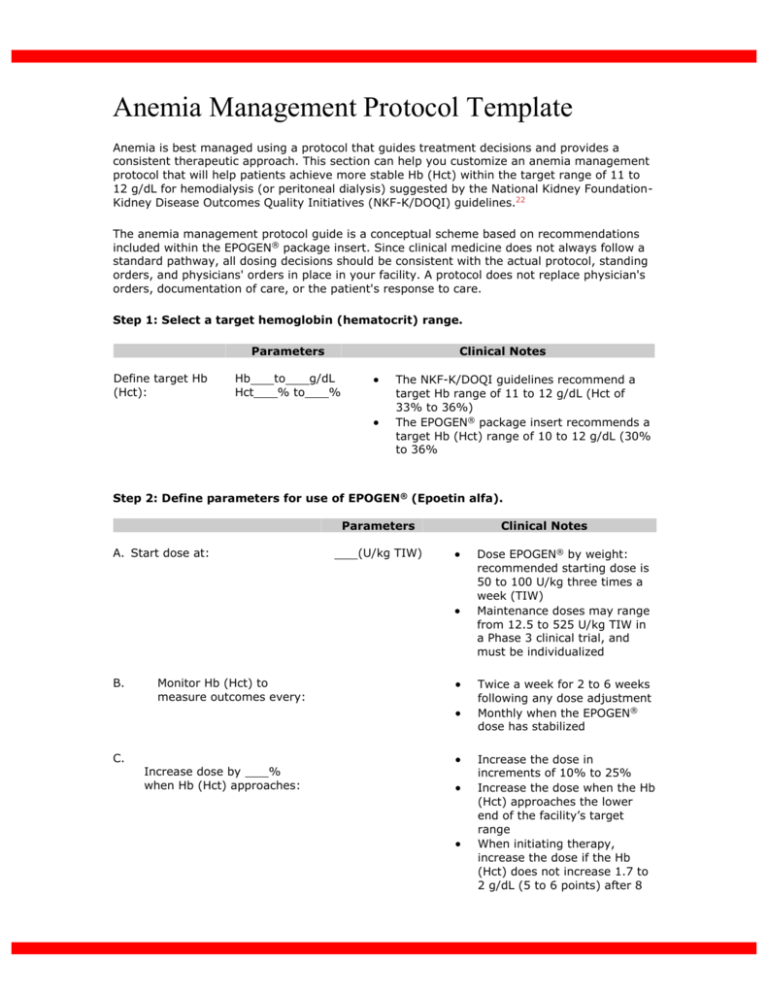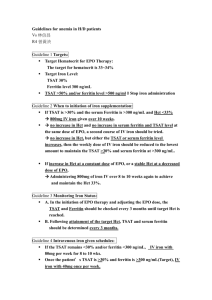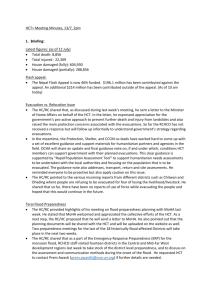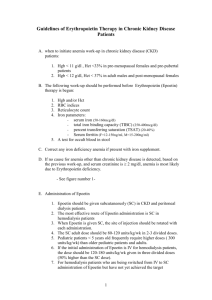Anemia Management Protocol
advertisement

Anemia Management Protocol Template Anemia is best managed using a protocol that guides treatment decisions and provides a consistent therapeutic approach. This section can help you customize an anemia management protocol that will help patients achieve more stable Hb (Hct) within the target range of 11 to 12 g/dL for hemodialysis (or peritoneal dialysis) suggested by the National Kidney FoundationKidney Disease Outcomes Quality Initiatives (NKF-K/DOQI) guidelines.22 The anemia management protocol guide is a conceptual scheme based on recommendations included within the EPOGEN® package insert. Since clinical medicine does not always follow a standard pathway, all dosing decisions should be consistent with the actual protocol, standing orders, and physicians' orders in place in your facility. A protocol does not replace physician's orders, documentation of care, or the patient's response to care. Step 1: Select a target hemoglobin (hematocrit) range. Parameters Define target Hb (Hct): Hb Hct to g/dL % to % Clinical Notes The NKF-K/DOQI guidelines recommend a target Hb range of 11 to 12 g/dL (Hct of 33% to 36%) The EPOGEN® package insert recommends a target Hb (Hct) range of 10 to 12 g/dL (30% to 36% Step 2: Define parameters for use of EPOGEN® (Epoetin alfa). Parameters A. Start dose at: (U/kg TIW) Clinical Notes B. Monitor Hb (Hct) to measure outcomes every: C. Increase dose by % when Hb (Hct) approaches: Dose EPOGEN® by weight: recommended starting dose is 50 to 100 U/kg three times a week (TIW) Maintenance doses may range from 12.5 to 525 U/kg TIW in a Phase 3 clinical trial, and must be individualized Twice a week for 2 to 6 weeks following any dose adjustment Monthly when the EPOGEN® dose has stabilized Increase the dose in increments of 10% to 25% Increase the dose when the Hb (Hct) approaches the lower end of the facility’s target range When initiating therapy, increase the dose if the Hb (Hct) does not increase 1.7 to 2 g/dL (5 to 6 points) after 8 D. Decrease dose by % when Hb (Hct) approaches: E. Hold the dose when Hb (Hct) is: weeks, and the Hb (Hct) is below the suggested target range Unless clinically indicated, dose adjustments should not be made more frequently than once every 4 weeks Decrease the dose in decrements of 10% to 25% Decrease the dose when the Hb (Hct) approaches 12 g/dL/36%, or the upper end of the facility’s target range If the Hb (Hct) rises more than 1.3 g/dL (4 points) in any 2week period, decrease the dose Unless clinically indicated, dose adjustments should not be made more frequently than once every 4 weeks Hold the dose of EPOGEN® (Epoetin alfa) when the Hb (Hct) is > 12 g/dL (36%) AND a 10% to 25% decrease in the dose does not slow the rate of rise in the Hb (Hct) Holding the EPOGEN® dose can lead to a dramatic decrease in the Hb (Hct). In some cases, Hb (Hct) levels > 12 g/dL may be appropriate on the basis of individual patient clinical characteristics, and the discretion of the physician. F. If the dose is held, check Hb (Hct) every: Check the Hb (Hct) weekly to determine trends Restart EPOGEN® at a reduced dose when Hb (Hct) is: Restart EPOGEN® at a 10% to 25% reduction in dose when the Hb (Hct) has decreased to within the facility’s target range Step 3: Define the parameters for use of iron.14,22-26 Parameters A. Select TSAT and ferritin target range: TSAT Clinical Notes % to % Ferritin ng/mL to ng/mL B. TSAT Monitor Ferritin TIBC C. Start oral iron at ; when: D. Stop oral iron and start IV iron when: E. Calculate the total dose of IV iron required to treat anemia and to replace iron stores/ongoing blood loss. The EPOGEN® package insert recommends regular evaluation of iron status for all patients receiving therapy. A TSAT >20% and a ferritin >100 ng/mL are recommended to support erythropoiesis. The NKF-K/DOQI guidelines recommend evaluating iron parameters at least every 3 months Iron deficiency is defined as TSAT < 20% and ferritin < 100 ng/mL Many dialysis patients will require higher levels Oral iron supplements are safe and inexpensive, but reduced intestinal absorption and poor patient compliance limit their effectiveness Oral iron may be sufficient for peritoneal dialysis patients Hemodialysis patients may require IV iron supplements Recommended dosing for oral iron = 200 mg of elemental iron per day Consider IV iron if oral iron is ineffective, or the patient cannot tolerate oral iron and TSAT and ferritin are below the facility’s target levels Rule out other causes of hyporesponse that may affect iron levels (see step 4) Calculate iron needs on the basis of actual iron deficiency and blood loss (see specific IV Iron Package Insert) For patients with poor dietary intake, add the calculation for replacing obligatory iron loss (average 1 mg/day = 365 mg/year) If necessary, administer a test dose before the initial dose. Administration of subsequent test doses during therapy should be considered. F. G. Discontinue IV iron and use oral iron when: Discontinue all iron supplements when: The patient has an allergic reaction Use caution when administering IV iron to a patient who has an infection/inflammation Safe upper limits for iron parameters in dialysis patients remain controversial The NKF-K/DOQI Anemia Work Group recommends maximum levels of 50% for TSAT and 800 ng/mL for serum ferritin In a subsequent analysis of safety considerations, Fishbane recommended that ferritin levels not exceed 500 ng/mL25 Step 4: Monitor outcomes and assess for causes of hyporesponse if the target Hb (Hct) is not achieved. NKF-K/DOQI recommends a target Hb (Hct) range of 11 to 12 g/dL (33% to 36%). The EPOGEN® (Epoetin alfa) package insert recommends a target Hb (Hct) range of 10 to 12 g/d Step 5: Document anemia management to achieve target Hb(Hct). Parameters Does your medical record include the following? Clinical Notes Most recent Hb (Hct) (include date) Target Hb (Hct) Rationale for target Hb (Hct) Current EPOGEN® (Epoetin alfa) Dose (if change required) New EPOGEN® Dose (if change required) Rationale for new EPOGEN® dose Physician signature and date





